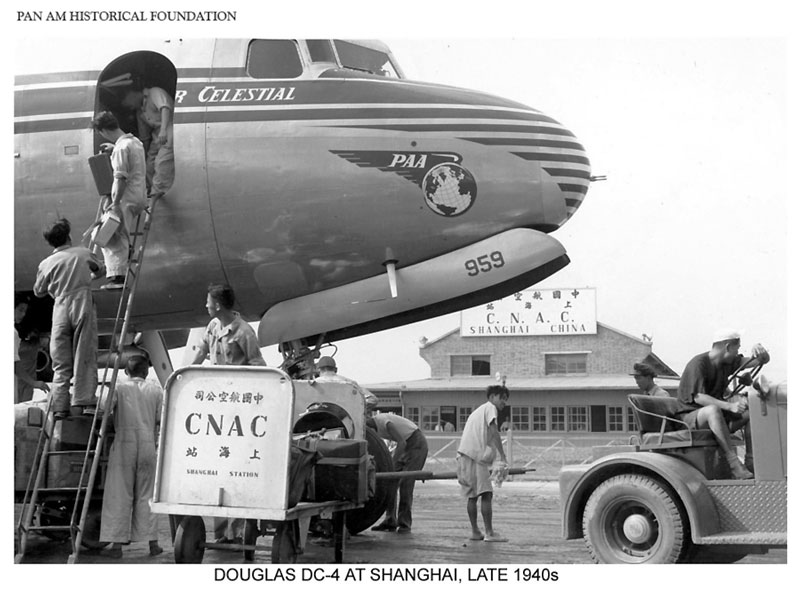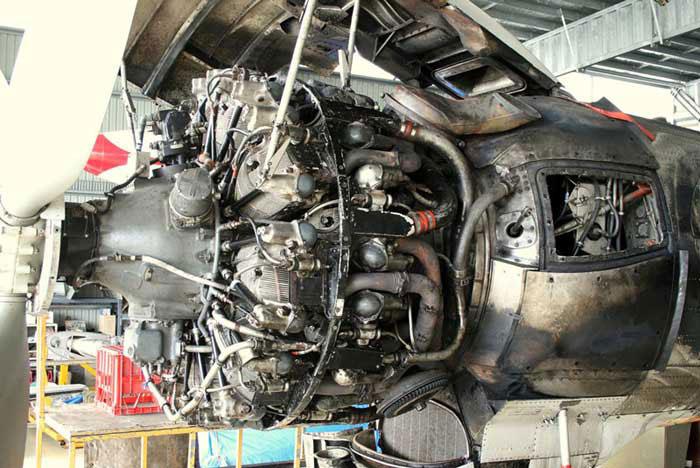"No Goose - No Gander"
Propliners' Crowning Achievement

Illustration by Mike Machat from Pan Am: An Airline and Its Aircraft by R.E.G. Davies and Mike Machat (1987). Used by Permission
By the mid-1950's, America was experiencing a booming post-war economy, and there was growing interest among newly affluent, and adventurous travelers in international air services – a fact not lost on air carriers who had been steadily investing in aircraft development that could accommodate the growing demand.
In the U.S. since World War II, three major aircraft manufacturers - Boeing, Lockheed, and Douglas – had courted contracts from airlines that in turn vied for market share. Boeing, based in Seattle, had for many years done well with military business and wasn’t as focused on the civilian side. The company was content to some extent to rest on its laurels with the luxurious B-377 Stratocruiser, introduced to service in 1949. Besides launch customer Pan Am, these distinctive aircraft (a civilian development of their B-29 bomber) were soon flying with Northwest, United, American Overseas, and BOAC. It was a luxurious plane, and appealed to the affluent clientele who were apt to fly to international destinations in the early 1950's. It was never a big seller though, and the last one of the 55 built was delivered to BOAC in 1950. Interesting to note that Wellwood Beall, Boeing's legendary design engineer - "father" of the B-314 flying boat - rode to Britain on that flight, and flew home to Seattle with confirmation that Britain's DeHavilland Aircraft Company was committed to developing an all-jet civilian transport, which would fly as the Comet I. Perhaps that cooled the ambitions of Boeing planners to pursue new piston-powered aircraft designs going forward.
Hundreds of miles to the south in Southern California, both Lockheed and Douglas continued to vie more actively for airline orders. While Douglas had had great success during the war building both DC-3's and DC-4's on military contracts - both of which were easily converted to peacetime use - Lockheed's production of transport aircraft was limited to the Constellation. It was a remarkable step forward when it first flew in 1943: pressurized cabin, hydraulically-boosted controls, de-icing on wings and empennage - and fast! (First versions could fly faster than a Japanese Zero fighter.) Lockheed was ready to continue development of the Constellation - there were both civilian and military customers. The first L-049 models were succeeded by an evolution of the line, leading up to the L-1049 "Super Constellation" and L-1649A "Starliner."
All of these variants, with increasing capacity and range, were powered by ever more complicated versions of Wright R-3350 engines, known as the "Double Cyclone," which used 18 cylinders arranged in two parallel rows. This big, powerful engine was quite a mechanical marvel, but was plagued, particularly in early versions, with overheating problems. The engine was introduced on Boeing's B-29 bomber and a catastrophic engine fire and ensuing crash of a prototype during a test flight in Seattle in 1943 took the life of test pilot Eddie Allen (instrumental in developing Pan Am's Boeing B-314 Clipper) along with everyone else on board and nineteen people on the ground. With time, improvements in the engine's design and related aircraft modifications reduced the hazards, but it was never an easily managed power plant, and required careful monitoring.

While Lockheed stuck with the Constellation design template as the 1950's progressed, not far away in Santa Monica, Douglas Aircraft had managed to survive the immediate postwar downturn in military orders, but was looking forward to the potential of expanding commercial work. The end of the war released scores of war surplus DC-4's to civilian markets – well over 1,000 had been built for military use - and the glut took some time to be absorbed. But the DC-4 was not adequate for increasingly demanding post-war passenger traffic. It was relatively slow, and being unpressurized suffered the vicissitudes of flying "in the weather." Pan Am had acquired dozens of these sturdy planes, as did many other airlines to re-open intercontinental air routes after the war, but the plane was handily outclassed by the Boeing Stratocruiser and Lockheed Constellation.
Fortunately for Douglas, they had something already in the works, thanks to a commission towards the end of the war from the U.S. Army to develop a pressurized variant of the DC-4. This became the DC-6, and by 1947, the first versions were flying on domestic routes in the U.S. The original DC-6 was followed into service by the DC-6B.

These pressurized aircraft were noted for their reliability (after an original fire-causing design flaw was fixed) and were widely used. Pan Am bought 45 DC-6B's and they greatly helped expand the airline's tourist class capacity following their introduction in 1952. The DC-6B proved to be a ubiquitous choice for many airlines. But it was not secret that the world would be demanding something more from aircraft manufacturers.
Despite the developments in aircraft designs, as the 1950's wore on, there was still a glaring gap in aircraft capabilities - range. Airlines were seeing the need for ever-longer route segments. For example, SAS the Scandinavian Airline System saw a market opportunity when they introduced flights from Copenhagen to Los Angeles in November 1954 via the Arctic "great circle" route. The flights, using DC-6B's, cut the trip down to 20 hours from the previous 30, when passengers were routed across the Atlantic through New York. One drawback remained: the range of the aircraft available required refueling stops in remote Greenland and northern Canada. On prestigious (and heavily traveled) North Atlantic routes, flights westbound flying into prevailing winds almost always necessitated refueling in Goose Bay, Labrador or Gander, Newfoundland.
The leap forward came with the introduction of the final generation of piston-powered airplanes. Douglas Aircraft did a bold revamp of their DC-7B (which started flying in 1955). The new plane was the Douglas DC-7C which added wingspan (the first change in Douglas's line of four-engine aircraft wing design since the DC-4), greater fuel capacity, lengthened fuselage, and an upgrade to more advanced Wright R-3350 engines. The result was a truly ocean-spanning airplane. The "Seven Seas" could reliably fly across the Atlantic in both directions nonstop. Pan Am ordered 26, the first one coming online in 1956. The airline started using them to fly the Arctic "great circle" route from Europe to Seattle in 1957.
Lockheed was quick to follow with the final iteration of the Constellation - the L-1649A "Starliner," powered like the DC-7C with the same model Wright R-3350 engines. TWA, Pan Am's chief American international competitor had them flying by June of 1957.

TWA Lockheed Constellation L-1649A "Starliner", NACA photo
The late variants of the R-3350 powering these planes were fitted with "power recovery turbines" or PRT’s - devices that returned some of the energy being shed from the big engine's 18 cylinders' exhaust stacks, increasing effective horsepower. But to mechanics that had to work on them, they were sometimes known as "parts recovery turbines" - the added heat retained by the engine sometimes caused them ingest their own exhaust valves. The temperatures of those exhaust gases spinning the PRT’s could reach 1,700 degrees F. The engines were expensive, complicated, and prone to mechanical problems. See The Engine History Historical Society at https://www.enginehistory.org/

Wright 3350 TurboCompound Engine -- Under the Hood.
In an article in the March, 1998 issue of "Flying" Magazine, author and pilot Len Morgan described some of the peculiarities of the Wright R-3350 he recalled from his days flying DC-7C's:
"The big Wright was incredibly complex and prone to lubrication and ignition problems. It required the tender loving care of a knowledgeable flight engineer who among many other things kept a sharp eye on the firing of each of 144 platinum-tipped spark plugs. Two dead plugs in the same cylinder dictated a precautionary shut-down. A 'cold jug' (non-firing engine cylinder) could cause serious internal damage. A number of 3350's . . . caught fire, sometimes with disastrous results."
 For all their problems, in the mid-1950's, these big engines were part of the solution to the challenges facing long-distance airline operations. But overshadowing the development of new long-legged piston airliners like the DC-7C and the L-1649A was the inevitable arrival of something completely different.
For all their problems, in the mid-1950's, these big engines were part of the solution to the challenges facing long-distance airline operations. But overshadowing the development of new long-legged piston airliners like the DC-7C and the L-1649A was the inevitable arrival of something completely different.
Pan Am's Juan Trippe had gone ahead in October 1955 - astounding his airline contemporaries - with an order for 45 new jet airliners from Douglas and Boeing. It would be three yeas before this first successful generation of jet aircraft would be carrying passengers. (All of DeHavilland's first Comets were grounded by a fatal design flaw.) Nonetheless, the writing was on the wall. Thanks to the Douglas "Seven Seas" and Lockheed's "Starliner", the world finally had reliable very long-range, truly inter-continental commercial aircraft.
The first Boeing jets had the same issue with range as did the earlier piston-powered aircraft, and flying west over the Atlantic, they usually touched down in Canada to refuel. But even so, jets flew almost twice as fast as did piston-powered aircraft, so passengers were still way ahead in terms of time. And for the airlines, the crucial metric of seat-miles was drastically improved with jets, which moved people (and generated fares) a great deal more efficiently and quickly. The equation permitted lower fares, and greater traffic. And - the icing on the cake - was the technological leap in terms of reliability of jet turbines over the big “recips” (reciprocating engines) turning propellers. As it had already gone with flight radio operators, before too many more years airlines could dispense with the services of flight engineers to monitor the engines – a substantial cost eliminated. There would be no going back.
Pan Am, Boeing’s first customer for the B-707, would not have reliably-nonstop transatlantic jet service in both directions till the arrival of models powered with newer turbofan engines in 1959. But the die was cast, and it would not be long before no airline would schedule piston-powered aircraft to fly the oceans. But it’s worth remembering that truly nonstop intercontinental air routes were already in place when jets arrived.




